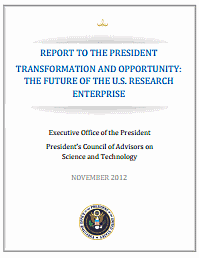|
News & Views item - December 2012 |
![]() Practical Benefits from Fundamental Research. (December 3,
2012)
Practical Benefits from Fundamental Research. (December 3,
2012)
The US President’s Council of Advisors on Science and Technology (PCAST) at the
end of last month released its report on
Transformation and Opportunity: The Future of the U.S. Research Enterprise![]()
 John
Holdren and Eric Lander, PCAST's Co-chairs introduce the report: ...The
Nation once led the world in investments in research and development (R&D) as a
share of gross domestic product (GDP), but more recently, the United States has
been investing less in R&D than other leading and emerging nations invest.
Moreover, U.S. industry has been shifting its investments toward applied R&D,
narrowing the support for basic and early-stage applied research, which is
crucial to transforming innovation... This report therefore addresses the two
objectives of (1) enhancing long-range U.S. investment in basic and early-stage
applied research and (2) reducing the barriers to the transformation of the
results of that research into new products, industries, and jobs. In this
report, PCAST describes a series of specific opportunities for the Federal
Government, universities, and industry to strengthen the U.S. research
enterprise.
John
Holdren and Eric Lander, PCAST's Co-chairs introduce the report: ...The
Nation once led the world in investments in research and development (R&D) as a
share of gross domestic product (GDP), but more recently, the United States has
been investing less in R&D than other leading and emerging nations invest.
Moreover, U.S. industry has been shifting its investments toward applied R&D,
narrowing the support for basic and early-stage applied research, which is
crucial to transforming innovation... This report therefore addresses the two
objectives of (1) enhancing long-range U.S. investment in basic and early-stage
applied research and (2) reducing the barriers to the transformation of the
results of that research into new products, industries, and jobs. In this
report, PCAST describes a series of specific opportunities for the Federal
Government, universities, and industry to strengthen the U.S. research
enterprise.
Among the actions that PCAST recommends, three stand out in scope and importance: (1) that you reaffirm your stated goal that U.S. total R&D expenditures (across the public and private sectors) should achieve and sustain a level of 3 percent of GDP; (2) that actions be taken, some achievable entirely by Executive decision, to increase the stability and predictability of Federal research funding; and (3) that Congress not only make the R&D tax credit permanent, but increase it to at least 17 percent, as you have already advocated.
Below is the introductory apologia for public support for fundamental research
by the federal government of United States, and the report as a whole allows an
interesting comparison with that of the recently released Australian
Government's
2012 National Research Investment Plan![]() .
.
_____________________________________
Practical results that are built on Federally supported fundamental research are
virtually everywhere in use. Fundamental break-throughs can be ascribed to the
support of many Federal agencies, including National Science Foundation (NSF),a
Department of Energy (DOE),b National Institutes of Health (NIH),c
National Aeronautics and Space Administration (NASA),d U.S.
Department of Agriculture (USDA),e and the National Oceanic and
Atmospheric Administration (NOAA).f While the following examples only
scratch the surface, it is worth contemplating how different the world would be
without each of these practical benefits of fundamental research. What would
today’s world be like without the Internet, modern drugs, computers, wireless
telecommunication, passenger jet aircraft, weather satellites, GPS, digital
cameras, or the knowledge of the human genome? The question is fanciful because
of the Nation’s consistent support of fundamental research over the last 60
years. Less fanciful, and subject to legislative and executive decisions, is the
question, “What about the next 60 years?”
The wings of all airplanes designed since
World War II owe their effectiveness to research by National Advisory
Committee for Aero-nautics (the predecessor agency to NASA) and, more
recently, to developments in computational fluid dynamics at U.S. National
Laboratories.
Nanotechnology research, on the heels of coordinated Federal investment, is leading to advances in areas such as new drug delivery systems, more resilient materials and fabrics, safer and more effective industrial catalysts, faster computer chips, and sustainable development in water and energy resources.
Cortisone and other medical steroids became
affordable in the 1950s only after USDA and NIH researchers discovered a
chemical precursor in a wild Mexican yam. Subsequent research in the private
sector led to the development of oral contraceptives and many other drugs.
Charge-coupled devices (CCDs) that record the images in all of today’s digital cameras and cell phones were a product of fundamental research at Bell Labs in the 1960s.
Bar codes, and more recently Quick Response
(QR) codes recognizable by cell-phone cameras, grew out of basic research in
computer vision and the pure mathematics of error-correcting codes.
References:
a "NSF Sensational 60" at www.nsf.gov/about/history/sensational60.pdf.
b DOE, "Technology Transfer Program Successes" at techtransfer.energy.gov/success/techtranstories.pdf
c "NIH Technologies in the Development of Healthcare Products" at
/www.ott.nih.gov/pdfs/techdev.pdf.d NASA Office of the Chief Technologist, "Success Stories" at www.nasa.gov/offices/oct/success/index.html.
e USDA Agricultural Research Service, "Technologies in the Marketplace" at www.ars.usda.gov/business/docs.htm?docid=769.
f NOAA, Office of Research and Technology Applications at www.oar.noaa.gov/orta/.